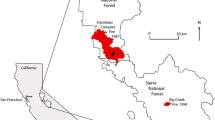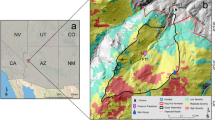Abstract
Every year, and in many countries worldwide, wildfires cause significant damage and economic losses due to both the direct effects of the fires and the subsequent accelerated runoff, erosion, and debris flow. Wildfires can have profound effects on the hydrologic response of watersheds by changing the infiltration characteristics and erodibility of the soil, which leads to decreased rainfall infiltration, significantly increased overland flow and runoff in channels, and movement of soil. Debris-flow activity is among the most destructive consequences of these changes, often causing extensive damage to human infrastructure. Data from the Mediterranean area and Western United States of America help identify the primary processes that result in debris flows in recently burned areas. Two primary processes for the initiation of fire-related debris flows have been so far identified: (1) runoff-dominated erosion by surface overland flow; and (2) infiltration-triggered failure and mobilization of a discrete landslide mass. The first process is frequently documented immediately post-fire and leads to the generation of debris flows through progressive bulking of storm runoff with sediment eroded from the hillslopes and channels. As sediment is incorporated into water, runoff can convert to debris flow. The conversion to debris flow may be observed at a position within a drainage network that appears to be controlled by threshold values of upslope contributing area and its gradient. At these locations, sufficient eroded material has been incorporated, relative to the volume of contributing surface runoff, to generate debris flows. Debris flows have also been generated from burned basins in response to increased runoff by water cascading over a steep, bedrock cliff, and incorporating material from readily erodible colluvium or channel bed. Post-fire debris flows have also been generated by infiltration-triggered landslide failures which then mobilize into debris flows. However, only 12% of documented cases exhibited this process. When they do occur, the landslide failures range in thickness from a few tens of centimeters to more than 6 m, and generally involve the soil and colluvium-mantled hillslopes. Surficial landslide failures in burned areas most frequently occur in response to prolonged periods of storm rainfall, or prolonged rainfall in combination with rapid snowmelt or rain-on-snow events.





Similar content being viewed by others
References
Allison RJ, Bristow GE (1999) The effects of fire on rock weathering: some further considerations of laboratory experimental simulation. Earth Surf Process Landf 24:707–713
Atkinson G (1984) Erosion damage following bushfires. J Soil Conserv Serv 40:4–9
Benavides-Solario J, MacDonald LH (2005) Measurement and prediction of post-fire erosion at the hillslope scale, Colorado Front Range. Int J Wildl Fire 14:1–18
Blackwelder E (1927) Fire as an agent in rock weathering. Am J Sci 35:134–140
Caine N (1980) The rainfall intensity-duration control of shallow landslides and debris flows. Geografiska Annaler 62A:23–37
Calcaterra D, Parise M, Palma B, Pelella L, (2000) Multiple debris flows in volcaniclastic materials mantling carbonate slopes. In: Wieczorek GF, Naeser ND (eds) Proceedings of 2nd international conference “Debris-flow hazards mitigation: mechanics, prediction, and assessment”. Taiwan, pp 99–107
Campo J, Andreu V, Gimeno-Garcia E, Gonzalez O, Rubio JL (2006) Occurrence of soil erosion after repeated experimental fires in a Mediterranean environment. Geomorphology 82:376–387
Cannon SH, Gartner JE (2005) Wildfire-related debris flow from a hazards perspective. In: Jakob M, Hungr O (eds) Debris-flow hazards and related phenomena. Praxis, pp 363–385
Cannon SH, Reneau SL (2000) Conditions for generation of fire-related debris flows, Capulin Canyon, New Mexico. Earth Surf Process Landf 25:1103–1121
Cannon SH, Bigio ER, Mine E (2001a) A process for fire-related debris-flow initiation, Cerro Grande Fire, New Mexico. Hydrol Process 15:3011–3023
Cannon SH, Kirkham RM, Parise M (2001b) Wildfire-related debris-flow initiation processes, Storm King Mountain, Colorado. Geomorphology 39:171–188
Cannon SH, Gartner JE, Parrett C, Parise M (2003) Wildfire-related debris flow generation through episodic progressive sediment bulking processes, western USA. In: Rickenmann D, Chen CL (eds) Proceedings of 3rd international conference “Debris-flow hazards mitigation—mechanics, prediction, and assessment”. Davos, Switzerland, pp 71–82
Cannon SH, Gartner JE, Wilson RC, Bowers JC, Laber JL (2008) Storm rainfall conditions for floods and debris flows for recently burned areas in southwestern Colorado and southern California. Geomorphology 96:250–269
Cannon SH, Gartner JE, Rupert MG, Michael JA, Rea AH, Parrett C (2010) Predicting the probability and volume of post-wildfire debris flows in the intermountain west, USA. Geol Soc Am Bull 122:127–144
Cerda A (1988) Post-fire dynamics of erosional processes under Mediterranean climatic conditions. Zeitschrift fur Geomorphologie 42:373–398
De Graff JV, Cannon SH, Gallegos AJ (2007) Reducing post-wildfire debris flow risk through the burned area emergency response (BAER) process. In: Schafer VR, Schuster RL, Turner AK (eds) Proceedings of 1st North American landslide conference. AEG sp publication, vol 23, pp 1440–1447
DeBano LF (2000) The role of fire and soil heating on water repellency in wildland environments: a review. J Hydrol 231–232:195–206
DeBano LF, Neary DG, Folliott PF (1998) Fire’s effects on ecosystems. Wiley, New York
Doerr SH, Shakesby RA, Walsh RPD (2000) Soil water repellency–its causes, characteristics and hydro-geomorphological significance. Earth Sci Rev 51:33–65
Doerr SH, Shakesby RA, MacDonald LH (2009) Soil water repellency–a key factor in post-fire erosion. In: Cerda A, Robichaud PR (eds) Restoration strategies after forest fires, 5. Science Publishers, Inc., USA, pp 197–223
Durgin PB (1977) Landslides and the weathering of granitic rocks. Rev Eng Geol 3:127–131
Durgin PB (1985) Burning changes the erodibility of forest soils. J Soil Water Conserv 40:299–301
Dyrness CT, Youngberg CT (1957) The effects of logging and slash burning on soil structure. Soil Sci Soc Am 21:440–447
Gabet EJ (2003) Post-fire thin debris flows: sediment transport and numerical modeling. Earth Surf Process Landf 28:1341–1348
Garfi’ G, Bruno D, Calcaterra D, Parise M (2007) Fan morphodynamics and slope instability in the Mucone River basin (Sila Massif, southern Italy): significance of weathering and role of land use changes. Catena 69:181–196
Gartner JE, Cannon SH, Bigio ER, Davis NK, Parrett C, Pierce KL, Rupert MG, Thurston BL, Trebish MJ, Garcia SP, Rea AH (2005) Compilation of data relating to the erosive response of 606 recently burned basins in the western US. USGS open-file report 2005, 1218
Giovannini G, Lucchesi S, Giachetti M (1987) The natural evolution of a burned soil: a three-year investigation. Soil Sci 143:220–226
Guerrero C, Mataix-Solera J, Garcia-Orenes F, Gomez I, Navarro-Pedreno J (2001) Different patterns of aggregate stability in burned and restored soils. Arid Land Resour Manag 15:163–171
Hanshaw MN, Schmidt KM, Stock JD (2009) The role of vegetation canopy removal on post-fire debris-flow rainfall intensity-duration thresholds. Geol Soc Abs Pro
Hubbert KR, Wohlgemuth PM, Preisler HK, Graham RC (2002) Effects of prescribed burning on selected soil properties in steep chaparral, southern California. Geol Soc Abs Pro
Huffman EL, MacDonald LH, Stednick JD (2001) Strength and persistence of fire-induced soil hydrophobicity under ponderosa and lodgepole pine, Colorado Front Range. Hydrol Process 15:2877–2892
Johnson AM (1984) Debris flow. In: Brunsden D, Prior DB (eds) Slope instability. Wiley, New York, pp 257–361
Kinner DA, Moody JA (2010) Spatial variability of steady-state infiltration into a two-layer soil system on burned hillslopes. J Hydrol 381:322–332
Larsen IJ, MacDonald LH, Brown E, Rough D, Welsh MJ, Pietraszek JH, Libohova Z, Schaffrath K (2009) Causes of post-fire runoff and erosion: water repellency, cover or soil sealing? Soil Sci Am J 73:1393–1407
Larson MC, Simon A (1993) A rainfall intensity-duration threshold for landslides in a humid-tropical environment, Puerto Rico. Geografiska Annaler 75A:13–23
Loaiciga HA, Pederos D, Roberts D (2001) Wildfire-stream flow interactions in a chaparral watershed. Adv Environ Res 5:295–305
Martin DA, Moody JA (2001) Comparison of soil infiltration rates in burned and unburned mountainous watersheds. Hydrol Process 15:2893–2903
May CL, Gresswell RE (2003) Processes and rates of sediment and wood accumulation in headwater streams of the Oregon Coast Range, USA. Earth Surf Proc Landf 28:409–424
Megahan WF (1983) Hydrologic effects of clearcutting and wildfire on steep granitic slopes in Idaho. Water Resou Res 19:811–819
Meyer GA, Wells SG (1997) Fire-related sedimentation events on alluvial fans, Yellowstone National Park, USA. J Sed Res 67:776–791
Meyer GA, Pierce JL, Wood SH, Jull AJT (2001) Fire, storms, and erosional events in the Idaho batholith. Hydrol Process 15:3025–3038
Mills AJ, Fey MV (2004) Frequent fires intensify soil crusting–physiochemical feedback in the pedoderm on long-term burn experiments in South Africa. Geoderma 121:423–437
Moody JA, Martin DA (2001) Initial hydrologic and geomorphic response following a wildfire in the Colorado Front Range. Earth Surf Proc Landf 26:1049–1070
Moody JA, Martin DA (2009) Synthesis of sediment yields after wildland fire in different rainfall regimes in the western Unites States. Int J Wildl Fire 18:96–115
Morton DM (1989) Distribution and frequency of storm-generated soil slips on burned and unburned slopes, San Timoteo Badlands, Southern California. In: Sadler PM, Morton DM (eds.), Landslides in a semi-arid environment with emphasis on the Inland valleys of Southern California. Publications of the Inland Geological Society 2, pp 279–284
Neary DG, Klopatek CC, DeBano LF, Folliott PF (1999) Fire effects on belowground sustainability: a review and synthesis. For Ecol Manag 122:51–71
Ollier CD, Ash JE (1983) Fire and rock breakdown. Z Geomorph N F 27:363–374
Ollier C, Calcaterra D, Parise M (2007) Studies in weathering and slope movements—an introduction. Geomorphology 87:101–103
Parise M, Cannon SH (2008) The effects of wildfires on erosion and debris-flow generation in Mediterranean climatic areas: a first database. Proceedings of 1st World Landslide Forum. Tokyo, Japan, pp 465–468
Roering JJ, Gerber M (2005) Fire and the evolution of steep, soil-mantled landscapes. Geology 33:349–352
Santi PM, deWolfe VG, Higgins JD, Cannon SH, Gartner JE (2008) Sources of debris flow material in burned areas. Geomorphology 96:310–321
Scott DF, Versfeld DB, Lesch W (1998) Erosion and sediment yield in relation to afforestation and fire in the mountains of the Western Cape Province, South Africa. South Af Geograph J 80:52–59
Shakesby RA, Doerr SH (2006) Wildfire as a hydrological and geomorphological agent. Earth Sci Rev 74:269–307
Swanson FJ (1981) Fire and geomorphic processes. In: Mooney HA, Bonniksen TH, Christensen NL, Lotan JE, Reiners WA (eds.) Fire regimes and ecosystem properties. US Department of Agriculture, Forest Service general technical report WO-26, pp 401–420
Wells WG (1987) The effect of fire on the generation of debris flows in southern California. In Costa JE, Wieczorek GF (eds.) Debris flows/avalanches: process, recognition, and mitigation, GSA Reviews in Engineering Geology 7, pp 105–113
Wondzell SM, King JG (2003) Post-fire erosional processes in the Pacific Northwest and Rocky Mountains Regions. For Ecol Manag 178:75–87
Woods SW, Balfour VN (2008) The effect of ash on runoff and erosion after a severe forest fire, Montana, USA. Int J Wildl Fire 17:535–548
Author information
Authors and Affiliations
Corresponding author
Rights and permissions
About this article
Cite this article
Parise, M., Cannon, S.H. Wildfire impacts on the processes that generate debris flows in burned watersheds. Nat Hazards 61, 217–227 (2012). https://doi.org/10.1007/s11069-011-9769-9
Received:
Accepted:
Published:
Issue Date:
DOI: https://doi.org/10.1007/s11069-011-9769-9




